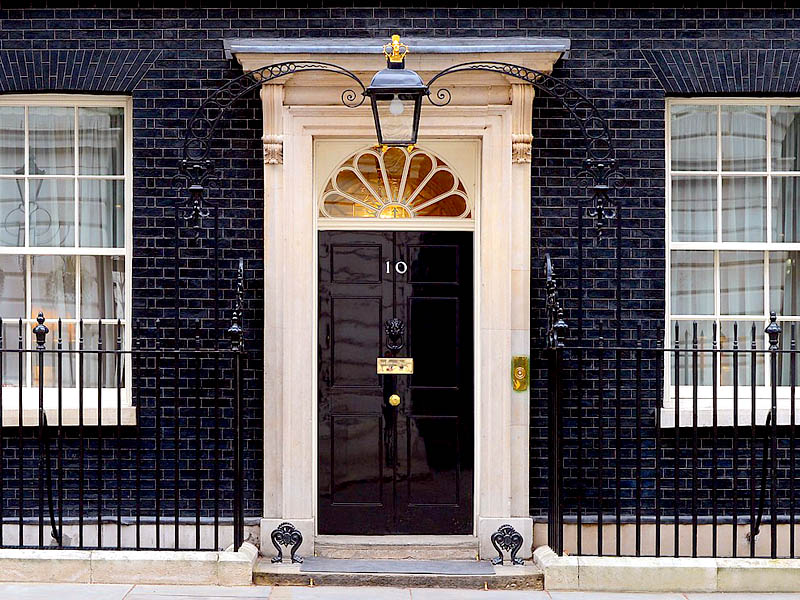
Professor Richard Bolden
- 25 October 2022
Share:
Over the past seven weeks the world watched on as Liz Truss crashed and burned as Prime Minister of the UK. After just 45 days in office — two weeks less than the election process through which she was appointed and, if you take out the period of national mourning for Queen Elizabeth II, shorter than the average shelf life of a lettuce (Economist, 2022, Daily Star, 2022) — Liz Truss unceremoniously stepped down as leader of the Conservative Party.
There is no shortage of journalists and political commentators writing their own accounts of what’s happened but, in this blog post, I would like to reflect on this as a leadership researcher and educator. To do this, I will consider the case from individual, organizational and societal perspectives.
An Individual Perspective: The Fall of Liz Truss
Without doubt, the most common way in which Liz Truss’s time in office will be analyzed is in relation to her own shortcomings and failures as a leader. The benefit of hindsight is a wonderful thing and there are many people coming forward to express the concerns they had about her character and suitability for the role of Prime Minister.
Over the past few days, I’ve heard her described as “tin eared,” “naïve,” “arrogant,” “stupid,” “talentless,” and many more things beside. Whilst these may or may not be a fair assessment of her qualities, they beg the question of why on earth her candidacy was supported by so many ministers and members of the Conservative Party if this is how they felt about her. Surely there was some evidence of this, or an attempt to assess her suitability, before she was given the biggest job in UK politics?
I’ve always been dubious about the motivations of anyone who would wish to become PM or President given the immense responsibility and public scrutiny such roles carry. Indeed, in a reverse Catch-22 type scenario, anyone ambitious enough to put themselves forward should perhaps be deemed unsuitable and hence ineligible for the role. There’s plenty of research evidence on the psychopathology of leadership and the risks of narcissism, greed, and corruption amongst senior leaders in all walks of life. Such toxicity is clearly not healthy, but it’s a mistake to lay the blame wholly on the individual leader her/himself — indeed we may need to take a closer look at ourselves.
The psychodrama of Westminster over the past weeks, months, years says perhaps as much about our own relationship to leaders and leadership as the individual protagonists themselves. In a recent book chapter I co-authored with Lucie Hartley, drawing on insights from her time as CEO of a drug and alcohol charity, we reflected on the addictive nature of leadership (Hartley & Bolden, 2022). While individual leaders may become trapped in destructive cycles of addictive behavior, the causes and consequences are not entirely of their own making. The tendency to romanticize leadership and the heroic qualities of successful leaders disguises the fact that we frequently place people in situations that would turn even the most admirable individual into something else.
While I have no doubt that Liz Truss willingly and enthusiastically embraced the opportunity to be Prime Minister, she did so at a time of extreme turbulence. Michelle Ryan and Alex Haslam (2005) coined the term the “glass cliff” to describe the circumstances in which female leaders and leaders from minority backgrounds are disproportionately more likely to be appointed to senior leadership roles in times of significant risk. While there are a number of possible explanations for this trend, it means that these individuals are placed in particularly precarious situations where the likelihood of failure is at its greatest. As the political commentator Andrew Marr stated in relation to the unraveling of Liz Truss’s government: “It was triggered by the immediate causes: bad political judgement, naiveté about markets, personal arrogance and cliquishness. Truss is simply not good enough — not shrewd enough in judgement, not persuasive enough as a communicator — to be prime minister. But this is the failure of an idea that would have collapsed even had Britain been led by better politicians” (Marr, 2022).
While I have no desire to present Truss as a victim, she became the embodiment of a set of ideals promoted by certain factions of her Party that were fundamentally out of step with the realities of the markets and wider society. She stated that in her commitment to growth she was prepared to do things that might be considered unpopular. Modeling herself on Margaret Thatcher, she claimed to be “a fighter not a quitter” and “not for turning”… until the markets and public opinion forced her to U-turn on pretty much everything she’d put in place during her time in office. We expect a lot of our leaders — including the ultimate act of self-sacrifice when things turn bad (Grint, 2010).
An Organizational Perspective: A Divided Party
The Conservative and Unionist Party of Great Britain is one of the main political parties in the UK. It represents the right-of-centre political interests and agendas and, within England at least, faces its main opposition from the left-of-centre Labour Party. There are currently 357 Conservative ministers, representing around 55% of all members of the House of Commons. The government comprises a Cabinet of senior leaders appointed by the PM and a large group of “back bench” members of parliament (MPs) elected to represent the interests of their local constituencies. An oppositional form of government is maintained, whereby, the party in power sits opposite the opposition parties in the main chamber of the House of Commons and legislation and policies are debated and voted on by members.
The origins of the UK structure of government dates back to the 13th and 14th centuries, with current arrangements largely unchanged for over 100 years. Unlike typical organizations, the PM’s authority comes from the mandate gained through General Elections, which occur every 4-5 years, where the public get to vote for their preferred party/candidate. These are supplemented by local elections to approve changes in representation between the national election cycle and by occasional national referendums on key issues, such as the UK’s membership of the European Union in 2016.
Within such an environment, the ability of the PM to instill a sense of “confidence” and maintain “discipline” is key. While MPs usually vote along party lines, within a democratic system of government they have the freedom to vote in the way they believe best serves the interests of the electorate. There are occasional exceptions to this, such as the vote on fracking on the evening of Wednesday 19th October 2022 that descended into chaos when Conservative MPs were informed that it was a “confidence vote” and they were expected to vote “no” to a motion to ban fracking no matter what their personal opinion on the matter or the views of their constituents. Despite the attempts of party “whips” and senior Cabinet members to encourage (force) members to vote as directed, 32 (nearly 10%) did not register a vote.
The events of the past few weeks have highlighted deep divisions within the Party that have existed for many years. Rather than all Conservatives sharing a unified set of beliefs, values, and priorities it is a loose affiliation of divided factions. These are the issues that David Cameron was trying to resolve when he called the national referendums, firstly on Scottish independence in 2015 and then membership in the EU in 2016. He hoped that once they had been decided through a public vote, MPs would fall into line and follow the guidance of the PM and Cabinet. In reality, however, such votes — particularly Brexit — seemed to further cement divisions within the Party and have led to widespread resistance and challenge across the different sub-groups — fueling, in large part, the churn of senior leaders, including three Prime Ministers and four Chancellors of the Exchequer (responsible for managing the national budget) in the last few months.
Commentators suggest that the Conservatives need to find a “unity candidate” to replace Liz Truss, someone who can lead and engage people from across the whole party, but such people are in short supply. The contenders — Rishi Sunak, Penny Mordant, and (the former PM) Boris Johnson — are all divisive given that they represent the interests of particular stakeholders rather than the whole party… not to mention the wider country. While Sunak, the runner up in the previous election campaign, has now gained sufficient support to be named the new leader, he has a significant challenge ahead in engaging those who hold him personally responsible for the departure of Boris Johnson and the drama that has since unfolded.
At the end of the day, leadership is about building, rather than burning, bridges.
The social identity approach to leadership, outlined by Alex Haslam and colleagues (2020), highlights the need for leaders to be seen to represent the interests and identity of a collective and to be doing it for “us.” Application of these ideas to the COVID-19 pandemic by Jetten et al. (2020) goes further, suggesting that (1) leaders need to represent us, and in a crisis “us” becomes more inclusive; (2) leaders need to be seen to do it for us, and there is no place for leader exceptionalism; and (3) leaders need to craft and embed a sense of us, and this creates a platform for citizenship.
This mirrors evidence from the Center for Creative Leadership on the nature and importance of “boundary spanning” leadership — defined as “the ability to create direction, alignment, and commitment across boundaries in service of a higher vision or goal” (Ernst & Yip, 2009). Direction, alignment, and commitment are far from evident within UK politics at the moment, and with its absence, the sense of shared purpose and capacity for collaboration needed for effective leadership and governance have evaporated. As the long-standing Tory MP Charles Walker stated following the chaotic vote on 19 October — “I’ve had enough of talentless people putting their tick in the box, not because it’s in the national interest but because it’s in their own personal interest” (Walker, 2022).
A Societal Perspective: Uniting Around a Shared Purpose
To understand Liz Truss’s spectacular failure, however, it is not sufficient to just consider individual and organizational factors. The speed and scale of her demise was largely shaped by factors beyond the direct control of either her or her colleagues.
She came into her position at a time of significant economic and geopolitical turmoil. The Russian invasion of Ukraine and a number of related factors (including the legacy of COVID-19) had driven up fuel costs and impacted food production, which had a direct impact on the cost of living for people across the UK. There were urgent calls for support in helping businesses and working families as well as those already receiving benefits, to cope with the rising cost of bills for fuel, food, and a wide range of essentials. Rapid action was required to put systems and processes in place before the winter in order to minimize the adverse effects.
The policy advocated by Liz Truss and her allies was one of establishing the UK as a high growth, low tax economy. Described by some as “Singapore on Thames” and others as “Trussonomics” — the approach is founded on the idea of cutting red tape and taxes to drive economic growth. This “trickle down” approach proposed that cutting taxes for the wealthiest would benefit those on lower incomes by mobilizing spending and job opportunities. This vision was core to Truss’s campaign to be elected as Party leader and was presented as confident and optimistic in the face of her opponent, Rishi Sunak’s, campaign that spoke of hard times ahead and the need to reign in public spending. When 141,000 Conservative members voted on whom to elect as party leader in September 2022, 57.4% chose Truss over Sunak (Statista, 2022), quite probably because of the more inspiring vision she set out of a post-Brexit Britain.
While those Conservative party members who voted for her, however, may have been persuaded by her argument, the “markets” were far less sympathetic — particularly when her (then) Chancellor, Kwasi Kwarteng, announced a “mini budget” on 23rd September 2022 that included £45 billion of unfunded tax cuts. This “spooked” the markets and led to a rapid drop in the value of the pound, forcing the Bank of England to intervene, increasing interest rates and buying government bonds. The crisis in the financial markets was fueled, to a large extent, by the lack of communication and engagement between Truss and Kwarteng with the business and financial sector (including the Bank of England and, indeed, their own MPs) in advance of the announcements. The unusual decision not to check projections with the Office for Budget Responsibility (established to give independent advice on the UK’s public finance) further undermined confidence — leaving many to assume that the government’s plans were not based on robust analysis and would leave a large gap in the UK economy.
Together, these factors demonstrate the importance of building consensus and support with key stakeholders beyond the immediate team/organization before launching a significant shift in strategy. Without this, the perceived competence, credibility, and legitimacy of leaders can quickly evaporate, making it very hard (or impossible) to regain sufficient support to move forward. The series of U-turns on the policies within the mini-budget, while essential to rebuilding some kind of stability within the markets, whittled away what remaining authority Truss held such that there was no option than to eventually resign.
Where Next?
Today we find ourselves turning to a new leader of the Conservative Party — someone who will also take on the role of Prime Minister. Recent events illustrate the ambivalent relationship to leadership we have in the UK (Bolden & Witzel, 2018). We appear to love and hate our leaders in equal measure — to put them on a pedestal and then topple them when they fail to behave in ways, or to deliver, what we expect (despite the warning signs that might already exist or the incredible demands they face).
While the primary focus of the current crisis in UK politics is “leadership,” we may, perhaps, be advised to spend more time thinking about the importance of “followership.” While each of the contenders for the role of Prime Minister had their own group of loyal advocates, to be successful Rishi Sunak will have to gain the support of a diverse range of stakeholders — including his own party, business and financial services, the public sector and the wider UK population — and demonstrate how he will represent and deliver against their needs and aspirations rather than those of a narrow clique. At the end of the day, leadership is about building, rather than burning, bridges. It is about articulating and working towards a shared purpose that unites, rather than divides, those around them. Ultimately, this might require those in senior leadership positions to put aside their own personal ambitions in the pursuit of a genuinely collective endeavor. As with the apocryphal quote of a Roman Senator claiming “there go my people… I must go after them, so I can find out where they want me to lead them!” (Witzel, 2016) — the key to political leadership is to follow the “will of the people.” Whether or not anyone in the current UK government has the willingness or capacity to do this is yet to be seen.
References and Further Reading
Bolden, R. and Witzel, M. (2018) ‘Dis-United Kingdom? Leadership at a crossroads’ in S. Western and E.J. Garcia (eds) Global Leadership Perspectives: Insights and Analysis, London: Sage Publications, pp 161-169.
Bolden, R., Hawkins, B., Gosling, J. and Taylor, S. (2011) Exploring Leadership: Individual, organizational and societal perspectives. Oxford: Oxford University Press. – Second edition to be published in March 2023.
Daily Star (2022) LIVE: Can Liz Truss outlast a lettuce? https://www.youtube.com/watch?v=Sm-RE95lKJ0
Eardley, N. (2022) How big-bang economic plan and political turmoil sank Liz Truss, BBC News, 20/10/2022 https://www.bbc.co.uk/news/uk-politics-63335671
Economist, The (2022) Liz Truss has made Britain a riskier bet for bond investors, 11/10/2022 https://www.economist.com/leaders/2022/10/11/liz-truss-has-made-britain-a-riskier-bet-for-bond-investors
Ernst, C. and Yip, J. (2009) Bridging Boundaries: Meeting the Challenge of Workplace Diversity, Leadership in Action, 28(1), 3-6.
Grint, K., (2010) The Sacred in Leadership: Separation, Sacrifice, and Silence, Organization Studies, 31, 89-107.
Hartley, L. and Bolden R. (2022) ‘Addicted to Leadership: From crisis to recovery’ in Morgen Witzel (ed.) Post-Pandemic Leadership: Exploring solutions to a crisis, London: Routledge.
Haslam, S. A., Reicher, S. D. & Platow, M. J. (2020). The New Psychology of Leadership: Identity, influence and power, 2nd Edition. London & New York: Psychology Press.
Jetten, J., Reicher, S.D., Haslam, S.A. and Cruwys, T. (2020) Together Apart: The Psychology of COVID-19. London: Sage.
Kuenssberg, L. (2022) Tory leadership: Why would anyone want to be prime minister now anyway? BBC News, 22/10/2022 https://www.bbc.co.uk/news/uk-politics-63343723
Marr, A. (2022) The death of global Britain, New Statesman, 19/10/2022 https://www.newstatesman.com/politics/uk-politics/2022/10/andrew-marr-death-global-britain
Ryan, M. and Haslam, S. A. (2005) The glass cliff: evidence that women are over-represented in precarious leadership positions, British Journal of Management, 16, 81-90.
Statista (2022) Percentage of votes won in the Conservative party leadership elections in the United Kingdom in 2022, by round. https://www.statista.com/statistics/1323720/uk-conservative-leadership-leadership-elections/
Walker, C. (2022) I’ve had enough of talentless people, BBC News, 19/10/2022, https://www.bbc.co.uk/news/av/uk-politics-63320605
Witzel, M. (2016) The first paradox of leadership is – leadership! In R. Bolden, M. Witzel and N. Linacre (eds) Leadership Paradoxes: Rethinking leadership for an uncertain world. London: Routledge.

Dr. Richard Bolden has been Professor of Leadership and Management and Director of Bristol Leadership and Change Centre at Bristol Business School, University of the West of England (UWE) since 2013. Prior to this he worked at the Centre for Leadership Studies at the University of Exeter Business School for over a decade and has also worked as an independent consultant, research psychologist and in software development in the UK and overseas.
His research explores the interface between individual and collective approaches to leadership and leadership development in a range of sectors, including higher education, healthcare and public services. He has published widely on topics including distributed, shared and systems leadership; leadership paradoxes and complexity; cross-cultural leadership; and leadership and change. He is Associate Editor of the journal Leadership.
Richard has secured funded research and evaluation projects for organisations including the NHS Leadership Academy, Public Health England, Leadership Foundation for Higher Education, Singapore Civil Service College and Bristol Golden Key and regularly engages with external organisations.


